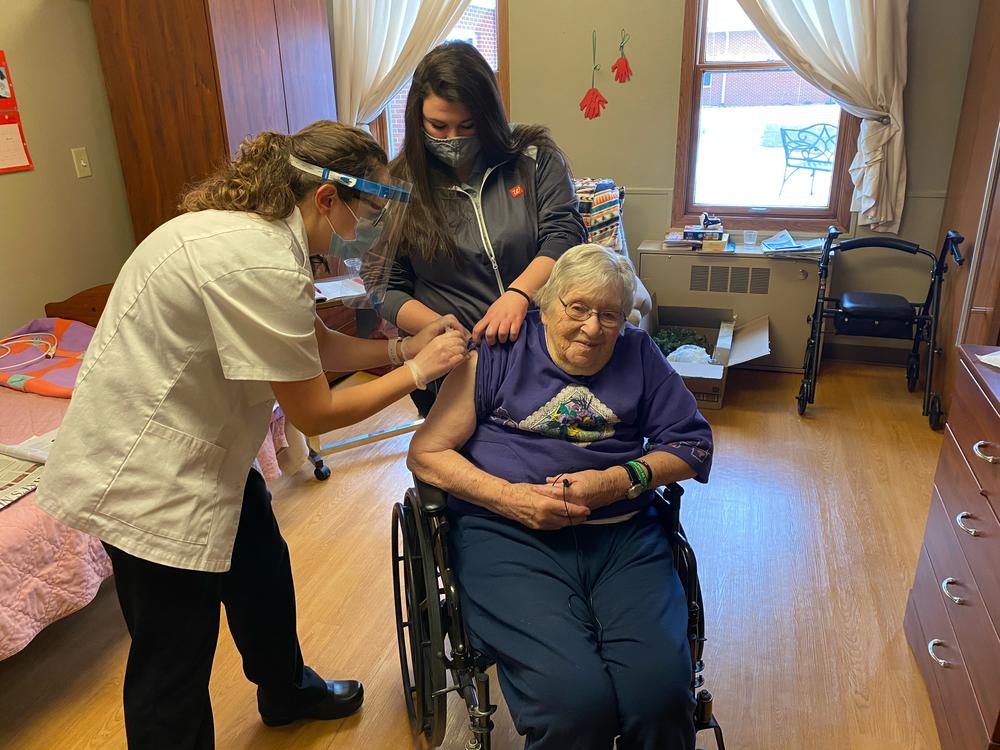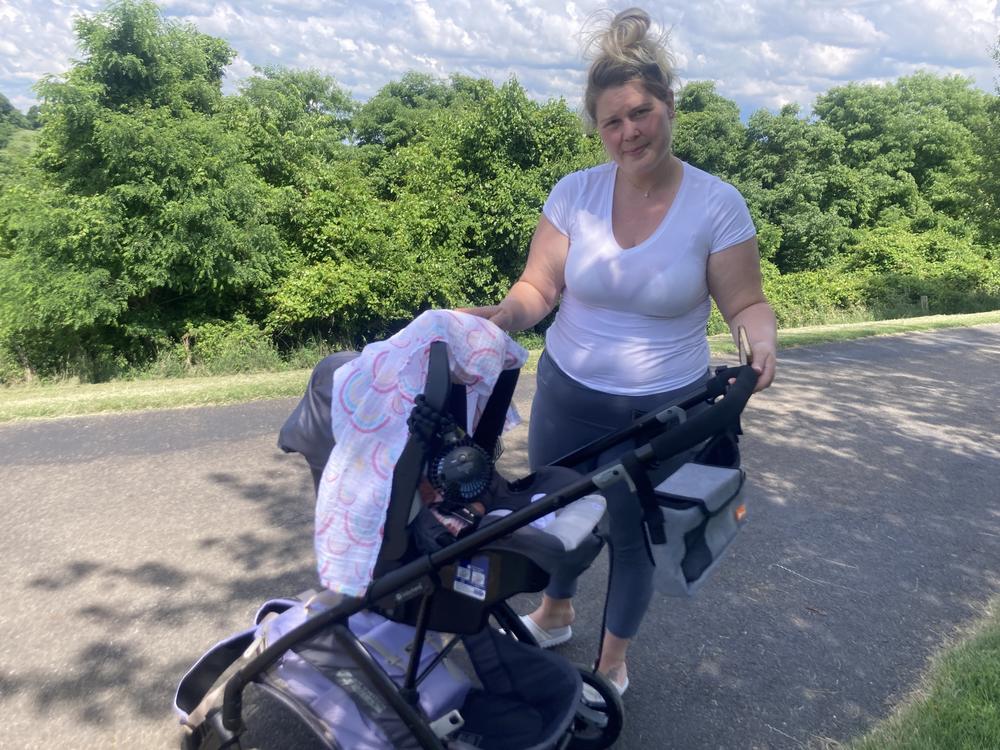Section Branding
Header Content
Nursing homes falling further behind on vaccinating patients for COVID
Primary Content
It seems that no one is taking COVID-19 seriously anymore, said Mollee Loveland, a nursing home aide who lives outside of Pittsburgh.
Loveland has seen patients and coworkers at the nursing home die from the virus.
Now she has a new worry: bringing COVID home and unwittingly infecting her infant daughter, Maya, born in May.
“She’s still so tiny,” said Loveland, whose maternity leave ended in late June. Six months is the earliest an infant can get vaccinated for COVID.
Loveland is also troubled by the possibility that the nursing home could experience a summer COVID surge, just like last year.
“It’s more amplified with the breathing issues because of how humid it is, how hot it is, how muggy it is,” she said.
Between her patients’ complex medical needs and their close proximity to each other, COVID continues to pose a grave threat to Loveland’s nursing home — and to the 15,000 other certified nursing homes in the U.S. where some 1.2 million people live.
Despite this risk, an April report found that just four out of 10 nursing home residents in the U.S. have received the most recent COVID vaccine, which was released last fall. The analysis drew on data from October 16, 2023 through February 11, 2024, and was conducted by the Centers for Disease Control and Prevention
The CDC report also revealed that during January’s COVID peak, the rate of hospitalizations among nursing home residents was more than eight times higher when compared to all U.S. adults, age 70 and older.
Billing complexities and patient skepticism
The low vaccination rate is partly driven by the fact that the federal government is no longer picking up the tab for administering the shots, said Dr. Rajeev Kumar, a Chicago-based geriatrician.
While the vaccine remains free to patients, clinicians must now bill each person’s insurance company separately. That makes vaccinating an entire nursing home more logistically complicated, said Kumar.
Kumar is president of The Society for Post-Acute and Long-Term Care Medicine, which represents clinicians who work in nursing homes and similar settings, such as post-acute care, assisted living and hospice facilities.
“The challenges of navigating through that process and arranging vaccinations, making sure that somebody gets to bill for services and collect money, that's what has become a little bit more tedious,” he said.
(In April, after the study was released, the CDC recommended that adults who are 65 or older get an additional dose of the updated vaccine if it's been more than four months since their last vaccine. That means that going forward, most nursing home patients who have had only one shot in fall or winter are not considered up-to-date on the COVID vaccine.)
Another issue is that Kumar and his colleagues are encountering more skepticism of the COVID vaccine, compared to when it first rolled out.
“The long term care population is a microcosm of what’s happening across the country, and unfortunately, COVID vaccine reluctance remains persistent throughout the general public. It’s our most significant challenge,” according to an emailed statement from Dr. David Gifford, chief medical officer at AHCA/NCAL, which represents both for-profit and not-for-profit nursing homes.
Nursing aide Mollee Loveland also has observed doubts and misinformation cropping up among patients at her job: “It’s the Facebook rabbit hole.”
But there are ways to push back against bad information, and states show wide variation in the proportion of nursing home residents who have been recently vaccinated.
For example, in both North and South Dakota, more than 60% of nursing home residents in those states have gotten at least one COVID shot since early October.
Building trust through relationships
One major medical system operating in the Dakotas, Sanford Health, has managed more than two dozen nursing homes since a 2019 merger with the long-term care chain the Good Samaritan Society.
In some of these nursing homes more than 70% of residents have been vaccinated since early October — at one Sanford facility in Canton, South Dakota, the rate exceeds 90%.
Sanford achieved this by leveraging the size of the health system to make delivering the vaccine more efficient, said Dr. Jeremy Cauwels, Sanford’s chief medical officer. He also credited a close working relationship with a South Dakota-based pharmacy chain, Lewis Drug.
But the most crucial factor was that many of Sanford’s nursing home patients are cared for by doctors who are also employed by the health system.
At the majority of Sanford’s North and South Dakota nursing homes, these clinicians provide on-site primary care, meaning patients don’t have to leave the facilities to see their doctors.
Another benefit of this integration is that Sanford clinicians and nursing home staffers both have access to the same patient medical records, which helps them keep track of which patients have and have not been vaccinated.
These employed doctors have been critical in persuading patients to stay up-to-date on their COVID shots, said Cauwels. For example, a medical director who worked at the Good Samaritan nursing home in Canton was a long-serving physician with close ties to that community.
“An appropriate one-on-one conversation with someone who cares about you and has a history of doing so in the past, for us, has resulted in much better numbers than other places have been able to get to nationally,” said Cauwels, who added that Sanford still needs to work on reaching the remaining patients who haven’t gotten the recent COVID shot.
Sanford’s success shows that the onus of getting patients vaccinated extends beyond nursing homes, said Jodi Eyigor, the director of nursing home quality and policy for LeadingAge, which represents nonprofit nursing homes. She said primary care providers, hospitalists, pharmacists and other health care stakeholders need to step up.
“What conversations have occurred before they walked into a nursing home’s doors, between them and their doctors? Because they’re probably seeing their doctors quit frequently before they come into the nursing home,” said Eyigor, who notes these other clinicians are also regulated by Medicare, which is the federal health insurance program for adults who are 65 and older.
Critics: shot uptake linked to residents’ dissatisfaction
Still, nursing homes are required to educate patients — as well as staff — about the importance of the COVID vaccines. Industry critics contend that one-on-one conversations, based on trusted relationships with clinicians, are the least that nursing homes should do.
But many facilities don’t seem to be doing even that, according to Richard Mollot, executive director of the Long Term Care Community Coalition, a watchdog group that monitors nursing homes. A 40% recent vaccination rate is inexcusable, he said, given the danger the virus poses to people who live in nursing homes.
A study from the Journal of Health Economics estimates that from the start of the pandemic through August 15, 2021, 21% of COVID deaths in the U.S. were among people who live in nursing homes.
The alarmingly low COVID vaccination rate is actually a symptom of larger issues throughout the industry, according to Mollot. He hears from patients’ families about poor food quality and a general apathy that some nursing homes have toward residents’ concerns. He also cites high rates of staff turnover, and substandard, and even dangerous, care.
These problems intensified in the years since the start of the COVID pandemic, Mollot said, causing extensive stress throughout the industry.
“That has resulted in much lower care, much more disrespectful interactions between residents and staff, and there’s just that lack of trust,” he added.
Mollee Loveland, the nursing aide, also thinks the industry has fundamental problems when it comes to daily interactions between workers and residents. She said the managers at her job often ignore patients’ concerns.
“I feel like if the facilities did more with the patients, they would get more respect from the patients,” she said.
So when administrators announce it’s time for residents to get the newest COVID vaccine, Loveland said, they often are simply ignored, even if it puts their own health at risk.
This story comes from NPR's health reporting partnership with KFF Health News.


